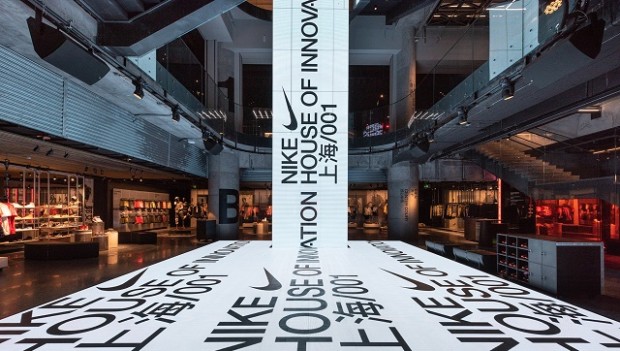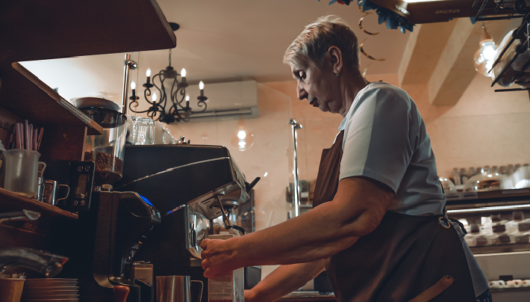
Retail in Asia has undergone some profound changes in recent years, including digitalisation, the development of the unlimited channel and new customer requirements.
Meanwhile, Chinese consumers are used to purchasing almost everything online, offering them better prices, variety and more convenience, so bringing these must-have components to the customer in-store is crucial.
Here are a few trends emerging from Asia this year that Western retailers would do well to take on board.
1. The return of the QR code
Only last year, there were a number of retail QR disasters, but now, the codes are truly transforming the retail experience in Japan and China. QR is empowering customers to move faster than ever through a store, or if they wish to, they can slow down and take in more of the experience. The QR code opens up another layer of opportunity for retailers to connect to their customer and create stickiness. For example the Samsung Galaxy flagship, offers many QR moments, each one opening up a shareable moment and cementing the customer’s loyalty to the brand.
QR codes are now more meaningful, driving the customer to scan, explore or engage. In China, consumers are already used to it; they use their phones for everything and scan dozens of QR codes every week. For instance, New Retail stores will allow users to try on clothes virtually, fill a virtual cart that will then be delivered to their home or pay via facial recognition without going to the checkout.
Where customers go, social media is quick to follow. Cath Kidson tags handbags with QR codes that direct consumers to themed Pinterest boards to inspire complete looks. At Alibaba’s supermarket Hema, you can now watch short reports on the origins of items by scanning their QR codes. This report provides transparency in a product’s origins, including audits and pictures of the distributor’s operating permits and food safety certificates. Education and quality produce matter to the Chinese consumer; New Retail and in this case QR codes make purchasing decisions quicker and easier.
2. Sustainability and lovability
With a consumer who is beginning to question the how, where and why of their purchases, retailers need to respond and act fast. Right now, showing they care is key to retail marketing strategy and as such they are very focused on doing better, being better and presenting this in any way possible in-store.
This care factor is presenting itself in all kinds of ways, but there are clearly some brands that are on this pursuit with more passion and intention than others. There are some that have care for the planet and its people at the heart of their brand, such as Toms. Toms’ entire shopper experience in Tokyo presents how they give back – even the store fit-out is built sustainably with repurposed crates, and reused and painted cardboard. A brand with a long-term view, they began with a strong sense of purpose in their business model and this hasn’t faltered.
According to Nielsen market research last year, “Brands marketed as sustainable or with sustainable credentials are growing 5.6 per cent faster than other brands”. Bottom line is, it pays to care.
Patagonia is another brand that has been very driven in its mission to not just sell stuff, but also do its bit for the planet. The entire store experience is centred around a powerful plea to its customers; the brand is saying, “We care, so you should too”, and people are getting onboard with this in a big way.
3. Surprise them with gifts
Timing, choice, quality versus quantity, the loyalty factor, personalisation – all of this impacts on the success of gifts with purchase.
There has been a confident upward trend in gift with purchase, a popular mechanism to encourage further custom and loyalty that is particularly strong in the beauty sector. Gift with purchase is nothing new, of course, but it’s becoming an integral aspect of shopper strategy and it is often used in collaboration with customisation, loyalty and other brand initiatives.
It’s amazing what a meaningful gift can do in the mindset of a consumer. Innisfree has an interesting approach as it doesn’t promote the program in-store but rather surprises the customer with a gift at the check-out. This means it’s not a sales driver, but a loyalty driver – also known as a return sales driver. The Innisfree gift with purchase was scaled – the more you spent, the more Innisfree product samples you were allowed to choose from. Presented as a pick-and-mix of goodies and popped into your bag, it mimics what many online beauty marketplaces add to basket. But in this case, you’re instantly satisfied, and it’s a seamless shopper experience.
The dimension of ‘choice’ with the gift is very clever. It takes this free offering to another level. The added bonus of choice with the gift is unexpected and reinforces this action of giving from the retailer. The importance of quality with gift with purchase shouldn’t be underestimated; this is an age in retail where even the gift that the customer didn’t expect has to be something highly coveted, something they want and need.
Gift with purchase is often connected to certain occasions or events, such as Lunar New Year – in Tokyo some sports retailers leveraged it into the Rugby World Cup. In a competitive landscape where consumers are not only making decisions between on- and offline but also between retailers, brands need to work harder to drive customers across the threshold.
4. Customisation rules
Consumers expect to be treated as individuals and they are seeking out experiences tailored to them; in Asia this is available in abundance. What is a product if it doesn’t have your name or initials stitched or engraved onto it? New Balance in Tokyo would agree, as the top level of their flagship store has a customisation station offering personalised stitching onto any product purchase. Or in Ralph Lauren, where you can create your own variation of your Ralph jacket, because uniqueness matters to our modern consumer.
Personalised shopping experiences exert a positive influence over customer purchasing behaviour. According to Adyen Australian Market Research, last year, 52 per cent of Australian shoppers claim to have made at least one additional purchase as a result of a personalised offer they had received.
With or without market research, it seems clear that customisation and personalisation of product and experience drives sales. It marries with the concept of generating scarcity. When brands present the opportunity for customers to attain a unique or one-of-a-kind product, particularly when there are only a limited number, it drives a different layer of excitement and brand loyalty.
Creating an interwoven, personalised shopping experience requires a commitment to bridging – and often modernising – technology systems and processes.
5. It’s about crossover
Mobile is set to eclipse desktop in terms of transaction volume for the first time this year, and it’s no surprise. This device is merging the shopping experience for the customer, it’s bringing convenience, variety and experience together as one.
Stats have shown that 91 per cent of Australian consumers own a smartphone. In Asia, the phone is integral to all shopper moments from payment through to experience.
Digital consumers, although strongly connected to the convenience of online shopping channels, still prefer in-store shopping experience. Retailers need to view the store as an opportunity to connect the dots for the customer, to deliver both the fast convenience and the unhurried experience they desire.
Your customer doesn’t think in terms of channels, they think in terms of emotions – “this is easy” or “this is fun”. The lines are blurring because customers often begin their journey in one channel and complete it in another, but often encountering a broken process preventing them from their desired outcome. Any friction in the path to purchase – however small – can derail them from committing to the basket or waiting in the queue in-store.
There are many moments of online and offline crossover in Asia, particularly in China with Alibaba’s supermarket, Hema Freshippo. It presents a unique amalgamation of online experience within the walls of its physical stores, with customers using the Hema mobile app to scan and purchase product, find out product information and capture recipe ideas. The store also doubles as a distribution centre, but not just any distribution centre, as customers can witness the presence of this channel crossover, with the collection and movement of online customers goods travelling on a conveyor belt around the ceilings of the store.
6. Bring on the games
It’s no secret that gaming is a rapidly growing space and expect to see more of it integrated into store experiences. Figures from Statista have shown that it’s a market that will reach $11 billion by 2021. Of course, Nike doesn’t offer just any in-store game, but a supersized interactive game that shows up on a screen travelling from floor to ceiling, all the way up to level four.
Nike worshippers are invited to play this game of speed and agility, consequently slowing up their time in-store. This game is the beating heart of the Nike House of Innovation Experience. It is the lifeline that literally runs through the store, pulsing, pinging and playfully engaging you on every level.
Gaming is part of many consumers’ leisure time now, so it comes naturally to see life through a screen and interact with digital characters, and Nike provides the perfect Augmented Reality experience in a retail setting: Hi-Panda.
Customers are handed an iPad at the entrance of the store. This iPad opens up another dimension in which to experience the anime Hi-Panda. As a customer walks into the space looking through the screen and around them, Hi-Panda is flipping, swirling and bouncing along the store, entertaining and interacting with the environment and even the product.
Gamification won’t be an effective strategy for all brands, but what is necessary for a brand to succeed in a modern shopping landscape is the ability to learn and adapt to how customers wish to interact with a brand.
In the case of digitally native consumers, this gamification a crucial aspect of how they generally exist and interact in society.
7. Brands working together
To a loyal Adidas fan, what’s better than an Adidas product? An exclusive Adidas collaboration. Often, brands that get to together with celebrity figures or other brands are seeking to shake things up a little and provide more for their customer, and those customers respond very positively.
Adidas and Y-3 partnership with Japanese fashion designer Yohji Yamamoto keeps Adidas fresh in the eyes of their Adi-fans and ensures that new generations still find relevance in these iconic brands.
Brand collaborations play with our human desire for new things, not a new idea, but thanks to social media, online shopping and digital journalism, our longing for newness is more prevalent than ever. Tommy Hilfiger mastered this with its influencer collaborations – one in particular with Gigi Hadid happened to coincide with the introduction of a ”see now, buy now” model, helped enormously by Instagram, that let fans indulge in instant gratification and shop the catwalk.
Today, the typical consumer is buying garments with increasing regularity. Where and how we shop is also changing, and brands from the high street to the upper echelons of the luxury fashion world are responding to this behavioural change.
Moncler is a brand that often draws the attention of visual merchandising aficionados, as well as their luxury-loving customers. But, Moncler is also responding to this demand for newness. It began in 2018 when Remo Ruffini relaunched Moncler with a project he brazenly named the Genius Group, and this concept is holding strong to this day.
The idea, according to Ruffini, was to bring different personalities and points of view into one label and to tap into the new ways shoppers are consuming.
The collections roll out one at a time on a monthly basis, which encourages continuous customer anticipation and excitement, ensuring this monthly drop and the Moncler brand is never far from the customer’s mind.
Ruffini reported an increase in online sales and web traffic, saying that “the initiative has attracted a notably younger demographic, and he claimed that the visibility and perception of the Moncler brand has improved”.
Jemma Caprioli is chief customer officer at Dashing Group.





